In a campaign season, especially a big general election like this one, parents and teachers want to give the kids a clue what’s going on. We’re also supposed to be training responsible citizens who will someday take part in the political process. If y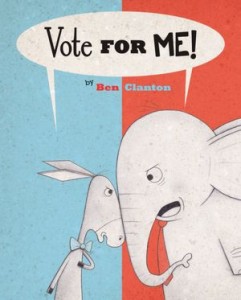 ou’re checking the library for books on the subject, it’s best to go prepared with an idea of how the subject should be presented. Four of the books below represent three general approaches: the cynical, the idealistic, and the informational. (The last book doesn’t represent much at all.)
ou’re checking the library for books on the subject, it’s best to go prepared with an idea of how the subject should be presented. Four of the books below represent three general approaches: the cynical, the idealistic, and the informational. (The last book doesn’t represent much at all.)
Vote for Me! By Ben Clanton. Kids Can Press, 2012, 40 pages. Age/interest level: 4-up.
Donkey and Elephant are dying to get your vote. Each claims to be a clear choice in contrast to the other: Donkey, colored pale blue, always appears on the left-hand page and Elephant (red of course) campaigns from the right. But their strategies are identical. From flattering the voter and making wild promises (“I’ll give you a sucker!”), they swiftly progress to name calling (“JUMBO!”) and literal mud-slinging. Their audience, an increasingly bewildered mouse, ends up running on a third-party ticket. Guess who wins? Vote for Me! is more a satire than exposition, but the humor seems too broad for most adults to appreciate, and while little kids as young as four may be amused, I’m not sure we want to inculcate a spirit of cynicism in our youth. Not this early anyway. And perhaps not even when they’re old enough to read . . .
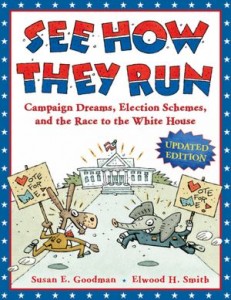 See How They Run: Campaigns, Dreams, Election Schemes and the Race to the White House, by Susan E. Goodman, illustrated by Elwood H. Smith. Bloomsbury, 2008, 95 pages including index. Age/interest level: 8-up
See How They Run: Campaigns, Dreams, Election Schemes and the Race to the White House, by Susan E. Goodman, illustrated by Elwood H. Smith. Bloomsbury, 2008, 95 pages including index. Age/interest level: 8-up
Made to look quirky and FUN!!—there is some good information here but packaged in frantic cartoons and lame jokes. Granted, the election process isn’t exactly dignified, and never was—check out George Caleb Bingham’s The County Election, 1852. We complain about it now, but it has always been kind of crazy. That said, the book suffers from a snide presentation that makes the reader feel superior to the forefathers who set this whole thing up. For example, a page called “Getting Better All the Time,” which celebrates how the Constitution has improved over the years, recycles the complaint about how only white male property-owners could vote at first. And did you know that women in eighteen countries, including the Soviet Union, could cast their ballots before American ladies? (As if female Russian wage slaves wouldn’t have moved here in a heartbeat if they could.) Skepticism about the Electoral College is understandable but one-sided. Historical snippets and sidebars illustrate the main text, with information on political parties, campaign shenanigans, and voter fraud. With the tone leaning toward the negative, you’d think it would discourage kids from participating in the democratic process when they grow up (or reach eighteen, whichever comes first). But “A Preachy but True Ending” reminds readers of all those women and minorities who couldn’t vote in 1787—as though the main reason for the existence of the United States is to extend the franchise as much as possible. Maybe someday 12-year-olds can vote—awesome! But in the meantime, kids, nag your parents until they haul themselves out of the Laz-Y-Boy and head for the nearest polling place. Whether they care or not.
Today on Election Day, by Catherine Stier, Illustrated by David Leonard. Whitman, 2012, 32 pages. Age/interest level: 5-8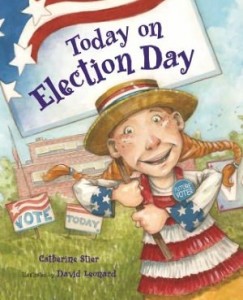
Through the eyes of six children in Mr. Harry’s fifth-grade class, we learn the basics of Election Day—who votes, where they vote, who they vote for, and how they made up their minds. To judge by the happy folks who throng these pages while participating in a campaign or traveling to their polling places, Election Day is the happiest day of the year! This book seems to go to the opposite extreme of See How They Run—it’s a starry-eyed celebration of voting as a sacrament in the civil religion of democracy. Some lip service is given to becoming informed, as David (whose name I learned from the book jacket, not the text) tells us that his brother Jake has just turned eighteen and
takes his responsibility as a voter very seriously! Jake read about the candidates in the newspaper and on websites. He talks about the election with his friends . . . He is especially interested in proposals about the environment and education. And look, there’s Jake zooming past [on his skateboard outside the school window]. He’s going to take me with him when he goes to vote.
Why is Jake swanning around on a skateboard when he should be in school, or at his job?! Of course he’s interested in “education” (free college!) and “the environment” (Big oil—BOO!). But that’s my cynical side emerging. In my opinion, the author does better service with
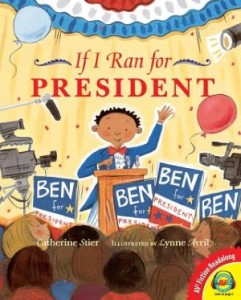 If I Ran for President, by Catherine Stier, illustrated by Lynn Avril. Whitman, 2007, 32 pages. Age/interest level: 6-8
If I Ran for President, by Catherine Stier, illustrated by Lynn Avril. Whitman, 2007, 32 pages. Age/interest level: 6-8
Ben, our first narrator, dreams about being President someday. But first he has to win a campaign. If I Ran for President describes what that means, from “throwing your hat in the ring” to winning your party’s nomination and using various media to get your message out. Having a message is given due recognition in this treatment, though of course the author can’t be too specific about issues. In a one-page introduction she explains the constitutional qualifications for the office, then gives a clear and straightforward explanation of the electoral college. After that we see the process through the eyes of children—five of them, in addition to Ben. As in This Day on Election Day, the narrators are not always clearly identified, and it might have been better to stick to just one. The process depicted in these pages is a cleaned-up version of the real thing, but as I indicated above, there’s no need to rub our kids’ noses in electoral mud-slinging and dirty tricks while they’re still elementary age. Democracy, it’s often been noted, is messy. That’s because the demos (people, not Democrats) are messy, and when segments of the demos want badly to win they’ll often use any means deemed necessary. That said, it’s a system that has worked for nigh on to 250 years, and as bitter as a contest may be, when the following January rolls around power changes hands without civil collapse. So far, at least. Without going all sentimental or strident about voting, that’s something to celebrate and be thankful for.
Fake Mustache, or How Jodie O’Rodeo and her Wonder Horse (And Some Nerdy Kid) Saved the US 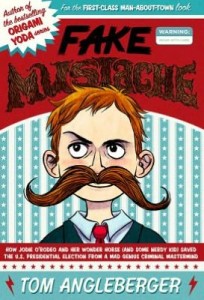 Presidential Election from a Mad Genius Criminal Mastermind, by Tom Angleberger, illustrated by Jan Wang. Amulet, 2012, 196 pages. Age/interest level: 9-12.
Presidential Election from a Mad Genius Criminal Mastermind, by Tom Angleberger, illustrated by Jan Wang. Amulet, 2012, 196 pages. Age/interest level: 9-12.
Lenny has no clue that there’s anything amiss when his friend Caspar insists on celebrating his birthday by buying a fake mustache and a man-about-town suit. Caspar drags his friend along on the shopping trip, first to Chauncey’s Big and Small, Short and Tall, where the proprietor yells at them to get the Helchfitz (warning: fake German swearing) out of his store. Then Caspar flashes the wad of birthday cash from his grandma, and voila: one man-about-town suit, coming right up. Next, Sven’s Fair Price Store, with its unsurpassed collection of real-hair mustaches. Here, Lenny is persuaded to part with his last ten dollars so Caspar can purchase the Heidelberg Handlebar #7. It’s a gift Lenny will have cause to regret, for so outfitted, Caspar embarks on a career of crime and deceit (i.e., a political campaign). Apparently the Heidelberg #7 has hypnotic powers, with which Caspar is able to persuade multitudes of people to vote for him for high office. He also persuades them that Lenny is the criminal mastermind, forcing his former best friend into hiding, where he encounters the cowgirl of the title. Then it gets complicated. This sounds like a story Tom Angleberger, author of The Strange Case of Origami Yoda, would cook up with his best friend while hanging out after a late-night basketball game. Beer might have been involved. A reader will learn next to nothing about the electoral process, but may acquire an inexplicable, deep-seated aversion to political candidates with mustaches.
To sum it up: A good picture book can help explain the process, but the best introduction to responsible voting is observing responsible adults. Discuss the issues with kids who are able to grasp them, respectfully comment on the candidates’ positions, and if possible take your children to the polling place with you. One caution, though: don’t run the subject into the ground. I know some young homeschooled adults who either avoid the political process or lean Democrat because their parents were so rabidly Republican. Democracy can seduce people into believing every problem has a political solution, when most problems begin in the individual heart. To vote is a privilege, not a panacea.
Support our writers and help keep Redeemed Reader ad-free by joining the Redeemed Reader Fellowship.
Stay Up to Date!
Get the information you need to make wise choices about books for your children and teens.
Our weekly newsletter includes our latest reviews, related links from around the web, a featured book list, book trivia, and more. We never sell your information. You may unsubscribe at any time.
We'd love to hear from you!
Our comments are now limited to our members (both Silver and Golden Key). Members, you just need to log in with your normal log-in credentials!
Not a member yet? You can join the Silver Key ($2.99/month) for a free 2-week trial. Cancel at any time. Find out more about membership here.
1 Comments
Leave a Comment
You must be logged in to post a comment.


Janie, I love your clear-sighted analyses–I always come away better informed and resolving to delve a bit deeper into underlying issues. Keep up the good–and very much appreciated–work! 🙂